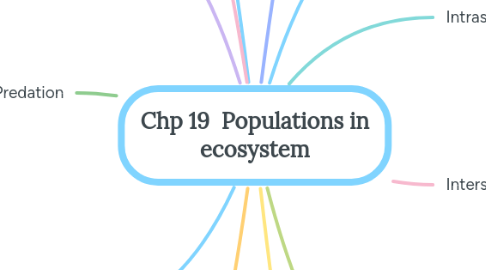Chp 19 Populations in ecosystem
by Matthew McConnell


1. Niches
1.1. niche describes how an organism fits into the environment - a niche refers to where an organism lives and what it does there
2. Competitive exclusion principle.
2.1. No two species occupy exactly thesame niche
3. Abiotic factors
3.1. Water and humidity. Where water is scarce, populations are small and consist only of species that are well adapted to living in dry conditions.
3.2. Temperature. Each species has a different optimum temperature at which it is best able to survive.
3.3. Light. As the ultimate source of energy for most ecosystems, light is a basic necessity of life.
3.4. pH. This affects the action of enzymes. Each enzyme has an optimum pH at which it operates most effectively
4. Predation
4.1. Predation occurs when one organism is consumed by another.
5. Effect of predator-prey relationship on population size
5.1. The relationship between predators and their prey and its effect on population size can be summarised: - Predators eat their prey, thereby reducing the population of prey. - With fewer prey available the predators are in greater competition with each other for the prey that are left. - The predator population is reduced as some individuals are unable to obtain enough prey for their survival or to reproduce.
5.2. - With fewer predators left, fewer prey arc eaten and so more survive and are able to reproduce. - The prey population therefore increases. - With more prey now available as food, the predator population in turn increases.
6. Succession
6.1. Succession takes place in a snies of stages. At each stage new species colonise the a rea and these may change the environment. These species may alter the environment in a way that makes it: - less suitable for the existing species. As a result the new species may out-compete the existing one and so take over a given area. - more suitable for other species with difkren1 adaptations. As a result chis species may be out-competed by the bener adapted new species.
6.2. The first stage of this type of succession is the colonisa tion of an inhospitable environment by organisms called pioneer sp ecies.
7. Definitions
7.1. Ecology - cology is the study of the inter-relationships between organisms and their environment.
7.2. Abiotic - Not living factors such as temperature and rainfall
7.3. Biotic - Living factors such as competition and predation.
7.4. Population - a group of individuals of one s pecies that occupy the same habitat at the same time and are potentially able to interbreed.
7.5. Community - the populations of different species living and interacting in a particular place at the same time.
8. Ecosystems
8.1. Major processes to consider: - the flow of energy through the system - the cycling of elements within the system.
9. Intraspecific competition
9.1. lntraspecific competition occurs when individuals of the same species compete with one another for resources such as food, water. breeding sites.
10. Interspecific competition
10.1. Imerspecific competition occurs when individuals of different species comp ete for resources such as food, light, water, etc. When populations of two species are in competition one will normally have a competitive advanrage over the other.
11. The relationship between predators and their prey and its effect on population size can be summarised as follows: - Predat.ors eat their prey, thereby reducing the population of prey. - With fewer prey available the predators arc in greater competition with each other for the prey that arc left. - The predator population is reduced as some individuals are unable to obtain enough prey for their survival or to reproduce.
12. Investigations
12.1. Quadrats
12.2. Belt transects
12.3. mark capture release
12.4. Estimated population size
12.4.1. total number of individuals in the first sample x total number of individuals in the second sample estimated / population size number of marked individuals recaptured
